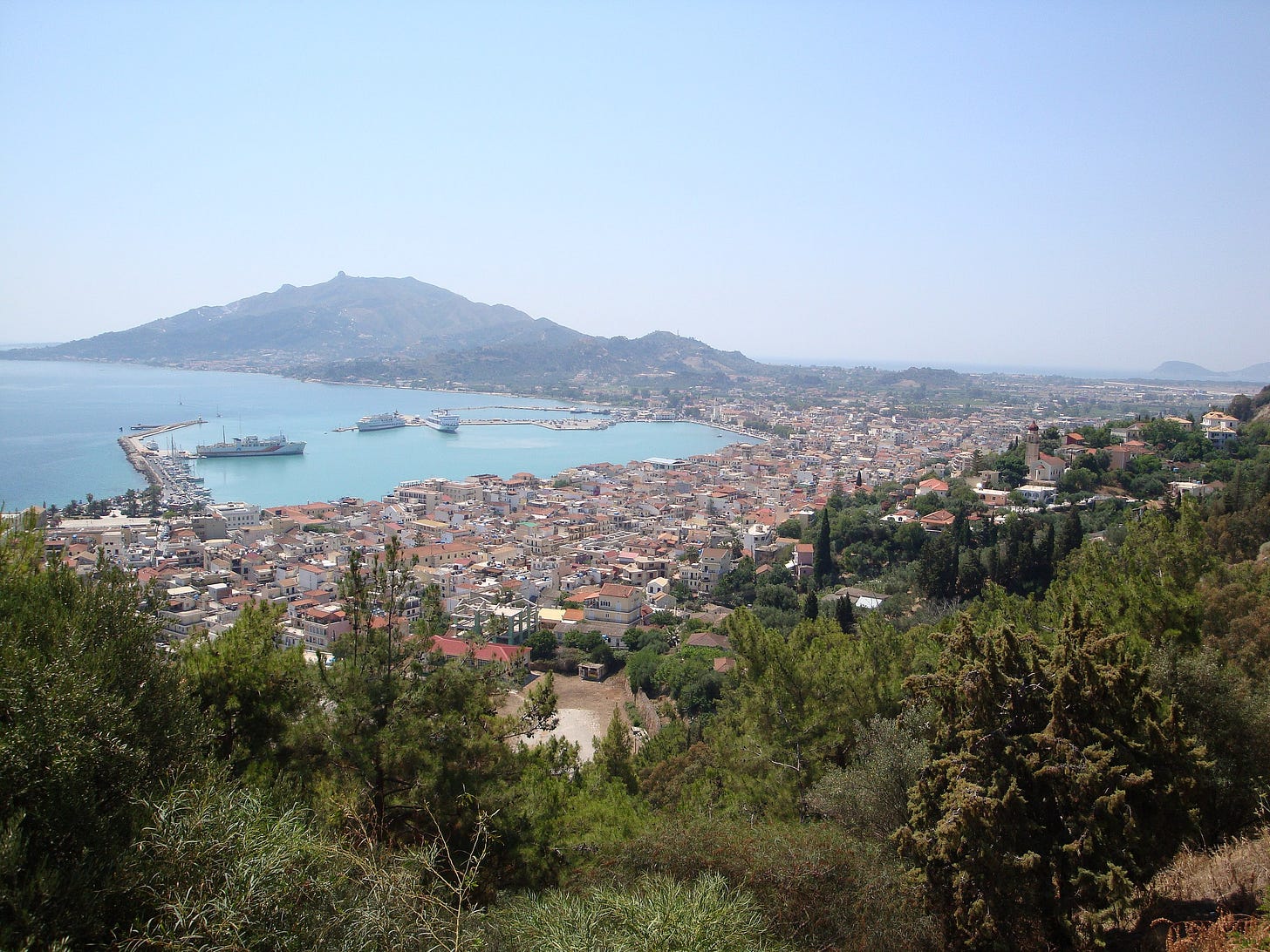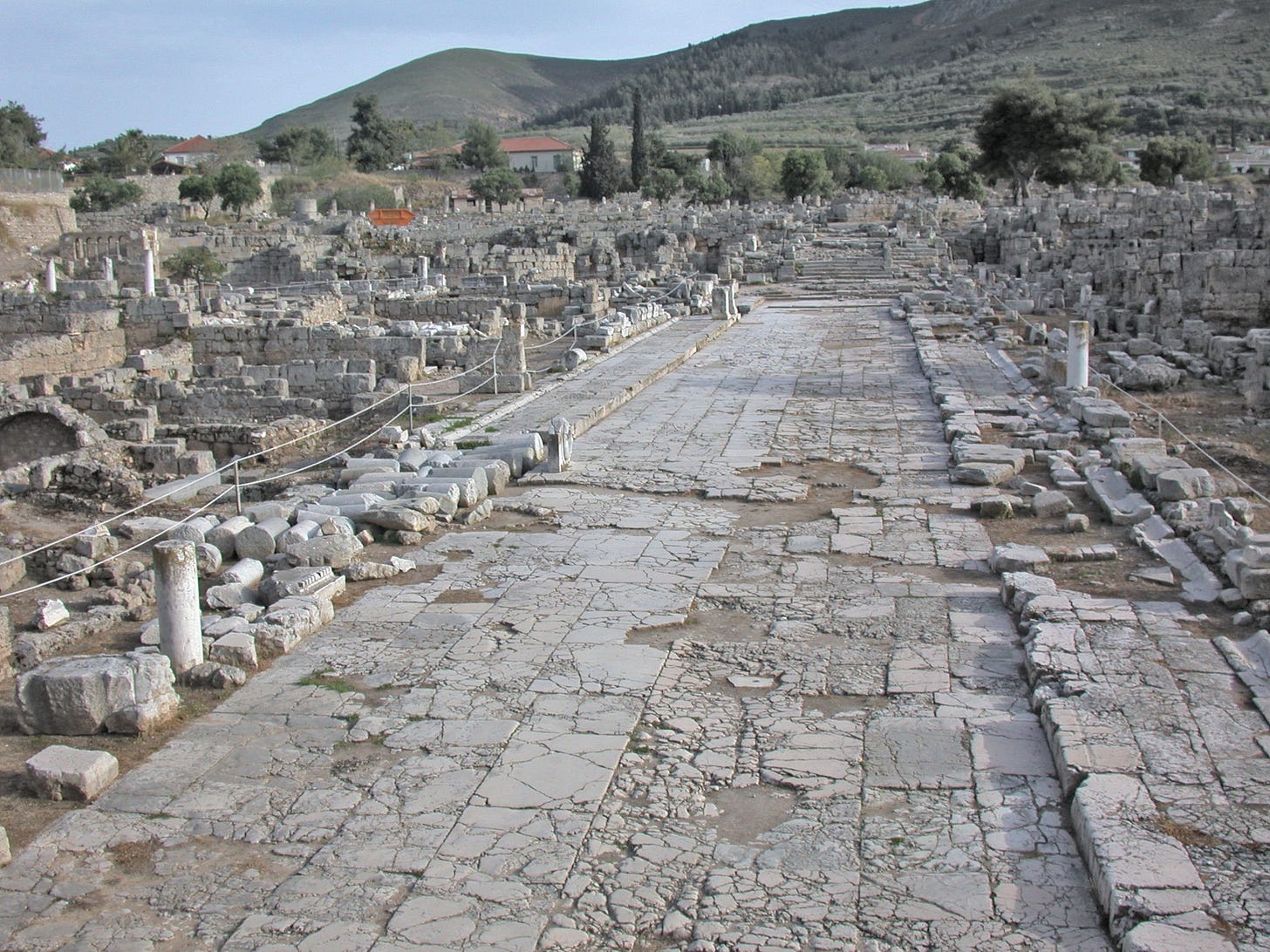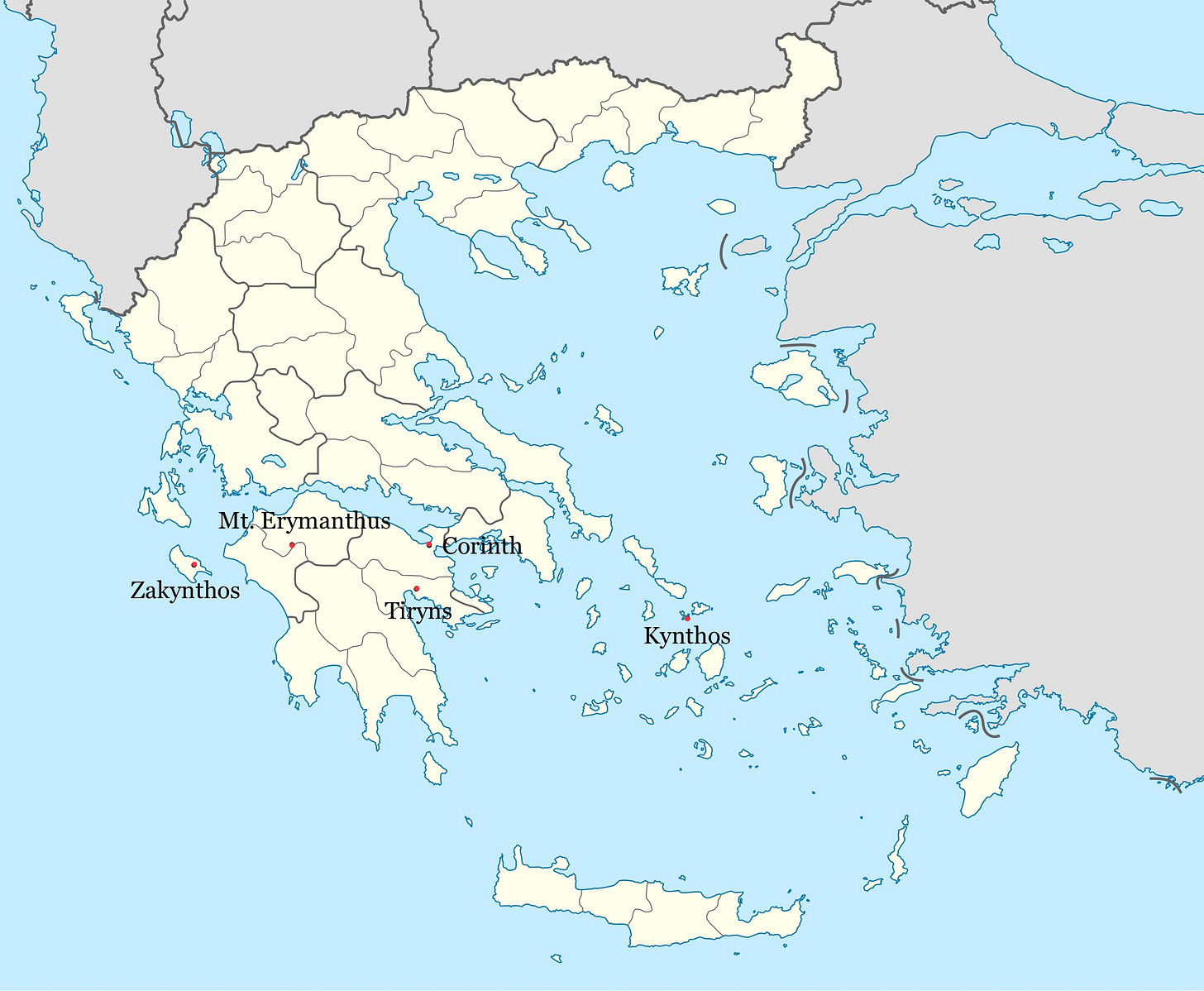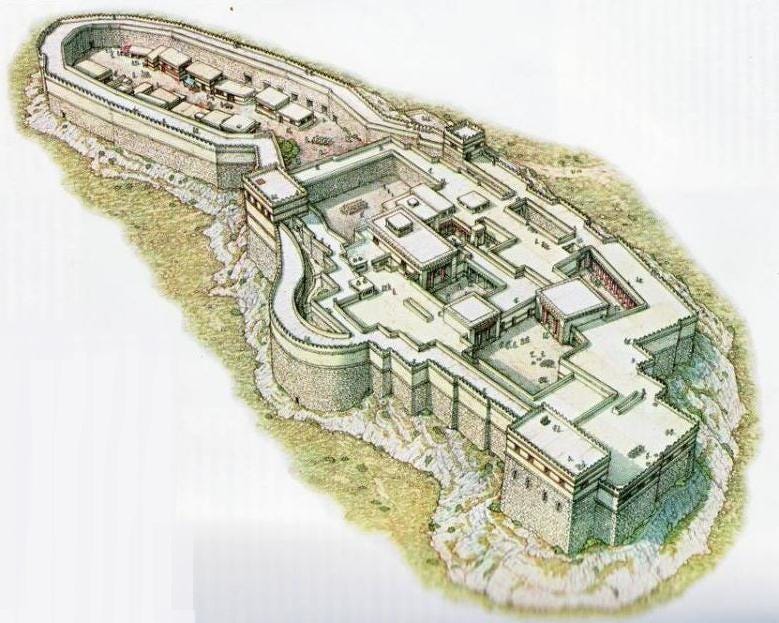Introduction:
The consonant cluster of Ancient Greek -νθ- (-nth-) is often cited as evidence of a Pre-Greek substrate language because there are no generally agreed-upon connections with Indo-European languages. For reference, the entry for Zakynthos in Wiktionary:
Etymology
Pre-Greek (assumed Pelasgian dialect), but Proto-Hellenic *zákuntʰos can be inferred.
This post proposes that place names in the Aegean in Ancient Greek with -νθ- (-nth-) and having no certain agreed-upon etymology might be from evolutions of Italic or Celtic noun endings -nts, -nti, or -ntes. These two language families were the closest geographically to Greece, and had varying influence over millennia. If this were an investigation, this consideration would be equivalent to interviewing the neighbors.
In some cases I have proposed that these Greek place names have similarity with later attested Hellenic, Latin, or Gaulish place names. These names should make sense as endonyms for groups of people or as descriptions of geographic features.
To test these ideas, this post speculates on the etymology of 5 place-names in the List of Greek place names sorted for -νθ- (-nth-) and having no certain agreed-upon etymology: Erymanthus, Zakynthos, Corinth, Kynthos, and Tíryntha (Tiryns), and shown here:
1. Ἐρύμανθος Erúmanthos (Erymanthus):
A name for a mountain range and nearby river in the north west of the Peloponnese, Greece. This area is shown with agricultural introduction c. 6000BC. A Roman folk etymology connected Erymanthus with Latin aro “I plow”, but it seems unlikely that a first-person singular root would be used to describe the mountain peaks or Erymanthus River.
The oldest form of the name Erymanthus is Linear B 𐀃𐀬𐀔𐀳 (O-RU-MA-TE)

The flowing Erymanthus River brings to mind words derived from Proto-Indo-European (PIE) *srew- “to flow, stream” used to describe waterways. The Erymanthus and the Alfeios Rivers dually form the ancient regional border of Elis and Arcadia. Near Tripotama is the the tripoint of Achaea, Arcadia and Elis and the “confluence of the rivers Erymanthos, Aroanios and Seiraios.”
If two streams were commonly thought of together as forming borders between ancient regions like Arcadia, Elis,and Achaea, then Linear B (O-RU-MA-TE) might represent:
Proto-Hellenic *hréumatə →
Linear B 𐀃𐀬𐀔𐀳 (O-RU-MA-TE)
Ancient Greek ῥεύμᾰτε (rheúmate) “(dual) streams, flows, currents”
Summary: Ἐρύμανθος (Erymanthus) is proposed to be of a Hellenic root that became Ancient Greek ῥεύμᾰτε (rheúmate) meaning “(dual) streams, flows, currents.”
2. Ζάκυνθος Zákynthos (Zakinthos):
The name of a Greek island and its city in the Ionian Sea off the western coast of the Peloponnesus and near to southern Italy. In Linear B, the name is 𐀼𐀓𐀯𐀍 (za-ku-si-jo). Agriculture introduction was c. 6000BC and approximately the same time as the Italian peninsula.

Proposals for Ζάκυνθος or Zákynthos:
The ZA- in Linear B 𐀼 is SA- in Latin and Celtic
The -KU- syllable 𐀓 in Linear B is equivalent to a ‘Qu’ or ‘Kʷ’.
The suffix -νθος was originally -ntes
Together, the proposal is Ζάκυνθος or Zákynthos was originally *SÁKʷENTES or Sáquentes, meaning “followers”:
Compare: Gaulish tribe Sequani, Latin sequentes “followers”
From Proto-Indo-European *sokʷ(h₂)-yo- “follower, companion”
Summary: Zákynthos is proposed to be an Aegean evolution of Italo-Celtic *Sáquentes/Sequentes meaning “The Followers” or “The Companions.”
3. Κόρινθος Kόrinthos (Corinth):
The city-state is on the isthmus connecting the Peloponnese to mainland Greece. The farming map indicates that the introduction of agriculture in Corinth was concurrent with the introduction of agriculture in Crete c. 6700BC, and Corinth was settled by agriculturalists originating from Crete.

The name Corinth is proposed to originate from the same word for Crete, and that the single name split and diverged in evolution after the Bronze Age collapse:
Italo-Celtic *karantes “friends” c. 6700BC →
Linear B 𐀐𐀩𐀳 *kerentes c. 1400BC →
Ancient Greek Ϙόρινθος (Kórinthos) c. 700BC
Ancient Greek Κρῆτες (Krētes) c. 700BC
Linear B rendered Crete as 𐀐𐀩𐀳 ke-re-te. Considering the Linear B orthography limits, the omission of complicated vowel or consonants might place an ‘n’ before a T, recreating *kerentes, a proposed Aegean evolution of *karantes “friends” from *kar-o “love” (Similar to Latin amicus “friend” from amō “I love”).
Compare: Gaulish Caranto- & Carantōna, Carinthia
Possibly: Carpi, Carian
^ Matasović, Ranko (2009), “*kar-o-” “love”, in Etymological Dictionary of Proto-Celtic (Leiden Indo-European Etymological Dictionary Series; 9), Leiden: Brill, →ISBN, page 191, page 190 for *karant
Summary: Both of the place-names Crete and Corinth are proposed to derive from the same Italo-Celtic / Proto-Celtic *karantes meaning “The Friends,” and this type of name is conceptually consistent with other proposed Aegean endonyms referring to groups.
4. Κύνθος Kýnthos or Kúnthos (Cynthus):
This is the name of a mountain located on the ancient and important island of Delos, part of the Greek Cyclades. The Cyclades were settled by agriculturalists concurrently with Corinth and Crete c. 6700-6000BC.

Following the reconstruction pattern, Κύνθος (Cynthus) could yield a variety of possibilities including *KENTES, *KANTI, *KʷENTI, or others . Without more information from a Linear B transcription, this leads to a wide range of considerations from Hellenic, Celtic, and Latin roots.
However, the names Cyclades and Cynthus are proposed to be conceptually consistent with both names referring to wheels:
Proto-Celtic *kantos “corner, rim” and also a sense of “rim of a wheel.”
Compare: Brythonic *Cantio, Latin Cantium, English Kent, Breton kant “circle”, Old Irish cétad “round seat”, Welsh cant “rim, edge”
Latin canthus or cantus “the iron ring around a carriage wheel; the tire”
This indicates a name consistent with circles, wheel parts, and chariots, similar to the name Κυκλάδες (Kukládes) or Cyclades “circles, rings.”
TLDR: The names Κύνθος (Cynthus) and Κυκλάδες (Cyclades) are proposed to be related to each other as ideas related to a wheel.
5. Τῑ́ρῠνς Tī́runs (Tiryns):
This name refers to a hill fort located in Argolis on the edge of the Argolic Gulf and near the modern town of Napflio with occupation ranging back at least seven thousand years. This region was settled by agriculturalists from Crete c. 6700BC according to the farming map, and it is included in the list of -nth- place-names because the genitive form in Greek is Tiryntha.
Ancient Greek Τίρυνς (Tī́runs) has no etymology listed.
Returning to Hellenic, it is noted that, “In Attic, the labiovelar *kʷ- becomes τ- before the front vowel ι…” For example, the interrogative “who, what”:
If the same change occurred with the initial Τῑ́- in Τίρυνς (Tī́runs), then reconstructing the earlier form of this name might have been something like *Quirins or *Kʷirins. These two forms closely resemble Quirinus, a very early god of the Roman state and a term used as an epithet, as in Janus Quirinus, Hercules Quirinus, or Mars Quirinus, the protector of the Quirites ("citizens" or "civilians").
Summary: The Ancient Greek Τίρυνς (Tī́runs) is proposed to be a name related to Quirinus, a word of Italic origin meaning “(pertaining to) the Citizens.”
The 5 place-names with -nth- and existing etymologies:
Ἄκανθος, Ákanthos: Ancient Greek ᾰ̓κή (akḗ, “thorn”) + ᾰ̓́νθος (ánthos, “flower”)
Ξάνθη Ksánthē: Ancient Greek ξανθός (xanthós) “yellow”
Note: the etymology of ξανθός (xanthós) is unknown
Ὄλυνθος Ólynthos: Ancient Greek ὄλυνθος (ólunthos, “wild fig fruit”)
Note: the etymology of ὄλυνθος (ólunthos) is unknown
Πέρινθος Périnthos Thracian *perunt (“rocky”)[1].
Note Thracian suffix -nt similarity to Proto-Celtic and Latin suffix -nts
Thracia was settled c. 6200-6000BC by agriculturalists from the Aegean, and this implies that the Thracian language shares descent from Proto-Italo-Celtic (pre-6000BC) and/or Proto-Celtic (post-6000BC) .
Σίνθος Sínthos Borrowed from Sanskrit सिन्धु (síndhu). Doublet of Ἰνδός (Indós)
References used in this post:
Etymological Dictionary Of Proto Celtic
Matasović, Ranko (2009), Etymological Dictionary of Proto-Celtic (Leiden Indo-European Etymological Dictionary Series; 9), Leiden: Brill, →ISBN
Wiktionary (etymologies)
Wikipedia (information)
The updated expansion of farming in western Eurasia map, with credit to authors in watermark:
The Heggarty et al (2023) Hybrid dispersal map of Proto-Indo-European languages (shown with dating in years Before Present or BP). Note the dating of early dispersal is much earlier than previously estimated, and note the dating and dispersal overlap with the farming map:

Thank you for reading. More names coming.
Nick DeSoto “Dad in SoCal” 28 September 2023 @ 12:48







